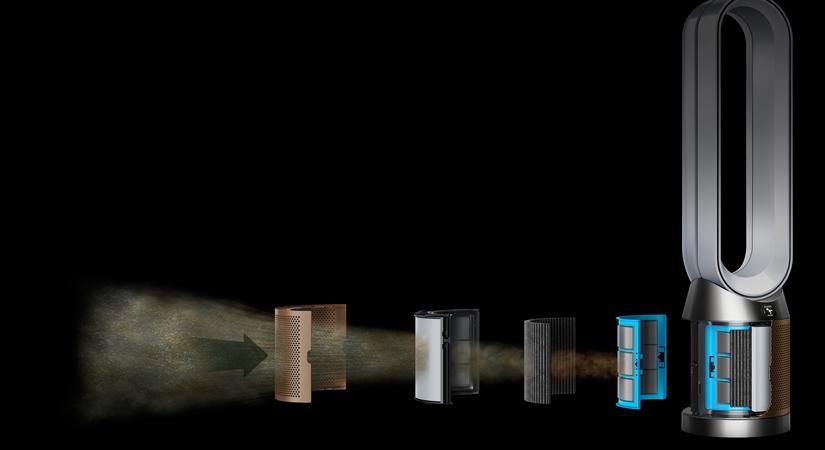Cover Story
Air purifiers for asthma

Dyson shows you how to pick one
ByIANSlife
May 1, 2022 (IANSlife) Our bodies consume more air than any other substance on a daily basis. With air quality worsening more than ever, we inhale a variety of pollutants, increasing the prevalence of a variety of health issues, including asthma. According to the 'Global Asthma Report 2018'1, 1.31 billion people (6 percent of whom are children and 2 percent are adults) in India suffer from asthma.
If you have breathing problems or health problems as a result of polluted air, you may be looking for cleaner air solutions. While staying at home may seem like the obvious solution, as homes become more tightly sealed, it may appear that we are shutting out pollution. On the contrary, we're closing it down. We are potentially breathing dirty air whether we are sleeping, working, cooking, or exercising. We have little influence over the quality of the air we breathe outside. However, there are steps we can take to protect our health and well-being at home. Purchasing an air purifier is one such option.
Dr. Neeraj Awasthy, Cardiologist, Pediatric Cardiologist and General Physician - Max Super Speciality Hospital, Saket says, “Both outside and indoor air quality can be catastrophic for our health. Our homes are a potpourri of myriad substances that may not be visible to naked eyes but contribute to an unhealthy home environment. There is a direct relation between the exposure to such bad air quality and flaring up of asthma and other breathing issues. Therefore, it is integral to identify such respiratory and asthma triggers to steer clear of these allergens. These days air purifiers are acting as a strong weapon to ensure respiratory wellbeing. They are capable of sensing and capturing harmful pollutants and eventually controlling asthma symptoms.”
Purchasing an air purifier could be a positive step toward providing clean air for you and your family. Ken Armstrong, Air Purification Scientist at Dysons, suggests how to choose the right air-purifier to suit your needs on World Asthma Day, which is organised by the Global Initiative for Asthma (GINA).
Purifiers come in a variety of shapes and sizes, remove various types of air pollutants in your home, and have a variety of features and specifications. Here are five things to consider before purchasing an air purifier.
Type of filter used:
There are different types of filtration and cleaning systems present in purifiers.
Ultraviolet light, for example, uses electromagnetic radiation to destroy bacteria, viruses and mould but do not remove dust, allergens or particles in the air. Activated carbon filters react chemically with pollutants to clear smoke, odours and gases from the air, but alone do not filter out harmful fine particles. Ionisers work by sending out a stream of charged ions to attract dust and allergens. While fairly popular, it is important to know ionisers can produce ground-level ozone. This raises indoor ozone, which can irritate your lungs.
HEPA H13 standard filters are highly effective at capturing 99.95 per cent of particles as small as 0.1 microns such as allergens, bacteria, H1N1 virus, pollen and mould spores. HEPA filters alone however, will not remove formaldehyde.
Dyson’s Selective Catalytic Oxidisation (SCO) filter continuously destroys formaldehyde at a molecular level. The catalytic filter has a unique coating, with the same structure as the Cryptomelane mineral. Its billons of atom-sized tunnels are the optimal size to destroy formaldehyde, breaking it down into tiny amounts of water and CO2. It then regenerates from oxygen in the air to keep destroying it continuously without ever requiring replacement.
Ability to remove fine and ultra-fine particles:
While seemingly fundamental, it is important to be aware of the invisible enemies that we are dealing with in our homes. In India, PM2.5 is the commonly mentioned particle size –which is prevalent in India, almost throughout the year. Particles unfortunately, do not stop at 2.5 microns. PM0.1 particles, also known as ultra-fine particles, tend to penetrate the fine sacs in our lungs (also known as alveoli) and may even enter our bloodstream easily.
Dyson’s latest purifiers capture 99.95 per cent of particles as small as 0.1 microns and achieve fully-sealed HEPA 13 standard filtration –ensuring that no air bypasses the filter and blocking any potential leak points through which dirty air might enter the machines.
Purifiers can be large and heavy, making them difficult to move between rooms. Lightweight purifiers, on the other hand, usually imply a reduction in coverage. However, there are some exceptions to this rule. Certain purifier models combine the functionality of a fan and an air purifier, giving you the best of both worlds.
(This article is website exclusive and cannot be reproduced without the permission of IANSlife)
IANSlife can be contacted at ianslife@ians.in


